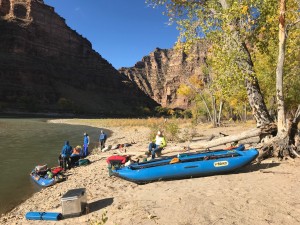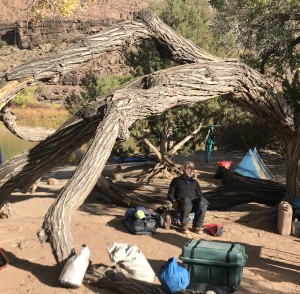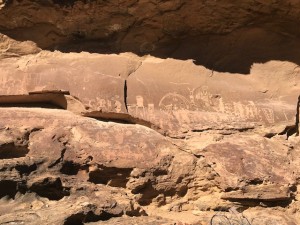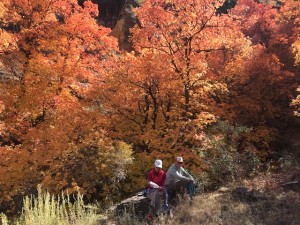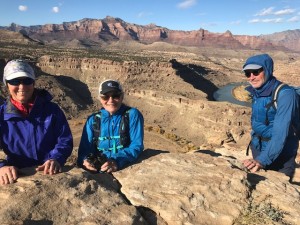CHAPTER 6: OCTOBER – FALL GLORY & LIFE STORIES
Following the tendrils back from a boat launch to the distant seeds of a trip’s genesis is a convoluted task, often encompassing thousands of miles, disparate starting points, a shifting cast of characters, complicated logistics, and a series of turning points at which the status of the journey, even its reality, teeter with doubt. This launch is at Sand Wash, Utah, on the banks of the Green River, above Desolation and Gray Canyons. We meet on a mid-October evening promising a near full moon, four of us arriving from Montana, and two more from Arizona, for a shared interlude of what we hope will be fall, not winter, on the water. But the twisting vines we have followed to get here snake back into the depths of January, when the seed was first planted.
It was Molly, she of gloved sainthood on the Grande Ronde, who mentioned in passing that she had been hankering for a ‘Deso-Gray’ fall float for years. We were coming up on river permit time, when scores of boating folk compete for the most coveted trips – the Rogue, the Smith, the Salmon, the Yampa, the San Juan, and various sections of the Green, among others. I had done the trip before, but always in the spring, and had heard about how nice it was in the fall. Marypat had never done it, and it ranked high on her trip to-do list. So we talked about dates in September that lined up with our other commitments, and applied. Weeks later we all got our river lottery responses, and we’d all been denied. Dang! Hate it when that happens, although it happens more often than not on these popular floats.
Things went quiet for a while after that. But then, by chance, I was talking to Lee, our paddling friend from Prescott, Arizona who had been introduced to the Montana boating crowd through my daughter, Ruby, and who had become the most far-flung member of our annual Three Rivers tradition.
“I’ve got a permit for October 16,” he said. “Not sure right now who’s coming. I talked to a former student who might be interested, and a couple of other people, but you’d be welcome.”
“Hmmm,” I said. “Let me get back to you on that.”
October was later than we preferred, but I talked to Marypat about getting time off from work at that time of year. I emailed Molly and Jeff. Everyone pondered the new target dates, other travel plans, family commitments, work duties. Calendars were out on kitchen tables, plans juggled, dates shifted. Weeks went past. No rush. The permit was secure, Lee was going, and we had time to consider.
A month or two later we talked again. “Could work,” said Jeff. “We’re coming back from another trip in September, but I think we could do it.”
Marypat was confident she could get the week off of work. I got back to Lee. “I think we’re coming,” I said. “I’ll keep you posted.”
Even then, details kept shifting, commitments wavered. There for a few weeks it looked like it might be quite a crowd, and Jeff balked at the idea of a parade of strangers, crowded camping and the inevitable clusterfuck of decision-making that comes with large groups.
“If it’s going to be eight tents at campsites I think we may back out,” he said.
But then the folks Lee had invited dropped out, one after another, until it was just two – Lee and his friend, David. Jeff and Molly were back in.
There was the nuts and bolts discussion about vehicles and gear. We decided to drive our rig. Jeff insisted that they pay for gas in exchange. We dealt with cook groups, boats, who brought the porta-potty and camp table and water jugs, how to arrange the vehicle shuttle. Who owed who for what. The usual.
At 6 a.m. on October 15th, still gray with dawn, we pull in to Jeff and Molly’s driveway. Our rig is loaded like an Oakie jalopy during the Dust Bowl, boats and paddles and coolers strapped to the roof, the back crammed with dry bags and duffels and food. All day we tool south, out of Montana, through Idaho, into Utah. Jeff entertains us with tidbits of arcane geologic history via a Roadside Geology book, such as the staggering discharge of a draining Lake Bonneville breaking out of a narrow pass and cascading over the arid section of Idaho we are driving across. Discussion ranges from gossip about friends to the app to find the cheapest gas along the way. Jeff brings up some suggestions for meaningful retirement endeavors. No one bites on his campaign to correct misplaced apostrophes in public spaces everywhere. Much more enthusiastic is our response to his idea of shooting down drones delivering resupplies to backcountry hikers.
“I’m in!” I say. “Then you could use their resupplies for your own trips!”
Finally we turn south onto dirt, near the town of Roosevelt, Utah and drive across oil and gas country nodding with pump jacks toward the river. It is dinner time when we arrive. Lee and David are there already, having made their own odyssey from Arizona, camping in Green River, Utah along the way.
Lee offers me a welcome-to-the-river IPA. “I’m taking a break from alcohol,” I give him my standard line.
“How much of a break?” he pushes me.
“Not sure,” I say. “It’s been since late June.”
“Yeah, I get it,” he says. “I stopped drinking for five years once.”
“Me too,” I said, “and I’ve decided it’s time to do it again.”
Before the sun goes down and the moon rises, we manage a quick dinner, erect tents, share some travel stories, and as dark falls we all head for sleeping bags. Then it gets cold. Really cold.
Marypat and I brought our double sleeping bag, and it isn’t up to the task. We sleep in our usual style, which is to say naked, and all night under a moon as bright as a streetlight, we cling to each other like barnacles to rock to share body warmth. Still we shiver through the hours and it is memorable enough that for the rest of the trip we wear socks, long underwear and wool caps to bed every night. When we rise to greet the sun the water jugs are frozen and everyone is hopping around waiting for coffee and wondering out loud whether they should have brought warmer sleeping bags.
Things at the launch are casual. At high season boating parties are rigorously checked out for proper gear, given the lecture on river protocol, told where to watch out for whitewater and other hazards. Throughout the spring and summer this access is teeming with groups jockeying for space. At this low pulse of the season, the ranger briefly checked in with David and Lee the night before. It was the last evening of his shift, and he planned to be gone before we got going in the morning. When he understood that we were all seasoned river trippers with several people who had done this section before, he waved them through. A few other groups are on the river this week, but rush hour on the Green is over.
Fortified with two cups of coffee and warmed by a couple hours of sun, we organize for river life. The pile moves from vehicles to boats, we all operate as human forklifts and take on the puzzle of fitting food and gear and water jugs and porta-potty and table and firepan into the hulls of boats, making sure everything is waterproofed and strapped securely.
“A little help for the blind guy?” David pipes up. “Can’t see to thread this strap.”
I lean over his rig and insert the strap into the tightening cam. “Kind of ironic, you asking for help from the half blind, half deaf guy!” I say.
David Lovejoy is compact and fit, a spry gnome of a man with a quiet sense of humor, a man who moves with an air of competence. He is also legally blind. He can no longer drive, so he depends on friends to get places and continue to take part in adventures. He is a nationally renowned climber and snow scientist, and is one of the founding visionaries of Prescott College in Arizona. He helped shape the college over a span of half a century and is still involved even in retirement. It is our first chance to share a trip with him.
The pace, once our boats are in the current, is lazy. “They allow us eight nights on the river,” Lee had said when we’d discussed the trip plans. “Might as well take them all.”
Marypat and I are soloing 14’ inflatable canoes using kayak paddles. Molly and Jeff share another in tandem style, and Lee paddles a 14’ hardshell solo canoe. David captains an inflatable kayak fitted with a narrow rowing frame. His boat is cunningly packed, with a cockpit space for him and bags strategically placed for foot braces. His oars are stubby things and his hull speed is slow, despite the fact that he rows constantly. He needs to keep a boat or two in close range, within his fuzzy field of vision, to know where to head. Our inflatable canoes are no greyhounds on the water, but we only need to lily-dip along to maintain his pace. It forces us to saunter, indulge in conversation, notice the surroundings, let the steady current carry us through the season. It’s an unfamiliar pace for Marypat and me. We’re used to a constant paddling rhythm, making a certain number of miles in a day, hewing to a schedule. This dawdling retirement pace takes getting used to, but as challenges go, I’ll take it.
The valley sides slope away in arid tiers, a golden eagle soars in the empty sky, temperatures edge into the 60s. On this river the unavoidable legacy of John Wesley Powell and his one-armed descent of the Green and Colorado in 1869 hovers over the scene. By the time Powell got here he’d already had some boat-devouring misadventures in the Canyon of Lodore, in rapids like Hell’s Half Mile and Disaster Falls. He and his men must have appreciated the sedate, unruffled pace of the river through here, although the rising canyon walls probably bumped up a few heart rates. Powell’s journals alternate between soaring descriptions of the sublime and brooding ruminations of foreboding.
Fall can be either hypothermic and squally, or lovely and pleasant. The year before, almost to the day, Lee and David launched with a group in rain and sleet. They had to camp early and get a fire built to huddle around. We get the warm version of the season on our first day, and the forecast looks good for the week. Eight miles down we unload up a steep sand bank and set the first camp in a rustling grove of cottonwoods. David and Lee each organize compact kitchens and hunker over their well-honed cook systems. We combine food space with Molly and Jeff around our camp table. Tents go up. The porta-potty sits behind some shrubbery downstream, angled for the view.
David and Lee have taken many trips together and they overlapped as teachers at Prescott College, so they have a familiar bantering tone with each other, spiced with rations of sarcasm in regular doses. Talk turns to future trips.
By this point in October we have already gotten plans underway for our top-to-bottom month on the Salmon River a year from now. The challenging crux in that plan was to nail down permits on the Middle Fork of the Salmon next September. The main lottery season ends September 3rd, but permits are still required to launch in the fall, and it’s competitive. The permit website opened at 8 am on October 1st to apply for the following year. Two weeks earlier we had a bevy of participants poised over computer keyboards when the clock struck eight. As fast as possible, we filled out the necessary group information, selected a date, and filed. Both Molly and I got a launch date, one on September 6th and the other on the 7th. No one else succeeded, and by 8:15 the entire month of September was booked – five launches a day, every day of the month, gobbled up in fifteen minutes. Getting permits for the main section of the Salmon a week into the descent is not competitive, so once we had a Middle Fork date secure, the trip became tangible.
Given the unpredictability of life a year out the trip is still on the aspirational side of the ledger, but September on the Salmon is firmly on the radar. The rest of the planning can wait. While we dip into wasabi snacks and drink our beverages, we bat around the challenges of the complicated shuttle, food resupplies, how many people will likely sign up for the entire month, and how many will pick a section. Jeff suggests a couple from New Zealand who he would like to invite.
The Green slides past. Our boats nod against their tethers. The sun goes over the canyon rim.
I have been a member of a local men’s group in Bozeman for many years. The group has been in existence for almost three decades; long enough that several members have died, people have moved away, marriages and relationships have waxed and waned, careers have morphed dramatically. Roughly a dozen of us meet on the evening of every second Wednesday during the school year. We open the meetings with a period of drumming, followed by a personal check in, and then embark on a topic presented by one of the members. There is a ‘talking stick’ and a certain protocol about how things go. We finish up before 10 pm and head home. The emphasis is on sharing emotions, generating ‘heat’, revealing difficult things. It is not about giving advice. It is most definitely not a book group. The membership is eclectic – medical practitioners, freelancers of different stripes, land brokers, bee-keepers, 9-5 laborers, contractors. Political leanings run from lefty liberals to gun-toting conservatives. Most of us don’t see each other outside of group meetings. The repeated act of sharing deeply over years, holding each other’s confidence tight, sitting together and listening to difficult revelations is profound. And rare.
One of the men’s group traditions is to share our life stories. Early on in the tenure of a new member we devote an entire evening, several hours, to listening to his biography, however he choses to present it. For that meeting, he holds the stick, he uncoils his history and the rest of us listen. That session, and the follow up questions, form the foundation for understanding context as years pass and new events come to bear. There is something primal about hearing a person’s backstory, like the ancient Greeks arriving on a foreign shore where they were anointed and feted and given the chance to share their tales. We don’t slather on the olive oil, but the significance of attending to the saga of a fellow human is the same. Where they come from. What they have endured. Who they love. What drives them. The turning points that have directed their lives.
Before this river trip it occurred to me that we had plenty of evenings for six of us to share our life stories with each other, and that it might be a meaningful way to pass time and get to know each other. It seemed a little awkward, but I thought this group might be open to it. Before we left I mentioned the idea to Marypat. Two nights into our trip she calls me on it.
“You’ve done this before,” she says. “Why don’t you start us off.”
“That’s what I get for opening my big mouth,” I say.
Night is coming on. We sit on a bench of firm sand a few feet above the river in a circle of camp chairs. Flames flicker in the fire pan. A pile of wood lies nearby. The first stars come out – Orion’s belt, Canis Major, Polaris. The tents are tucked under a twisted grove of scrub oak trees. Dinner dishes dry on the camp table. The air is calm and quiet. We each have a headlamp in a coat pocket, wear layers of long underwear and puff coats and wool caps. The rhythms of river life have started to take hold.
Yes I’ve done this before, but it is still daunting. Telling the story of my life requires stripping away the superficial veneer I present to the world, becoming vulnerable, trusting the people within earshot who will each interpret my words. Going deep, laying bare, opening up gives my listeners power to hurt me on some basic level. At the same time, I believe that becoming vulnerable puts me in an odd position of strength. If I reveal everything, what are they going to hurt me with? I do trust this circle of people. They are my friends. Besides, presumably they will grant me the same access to their quivering truths on subsequent nights around the campfire. At the end of the journey, we will all sit together in that same tippy boat of shared history.
I remind myself of one of the surprising lessons I’ve learned in my career as a writer. Much of what I’ve written is autobiographical in nature. As such, it is by definition revealing. I have recounted things I am not proud of, made admissions of weakness, exposed doubts and frailties. When a book or story comes out, I wait for the reaction to those personal quagmires. The reaction has never come. What I have come to realize is that my hidden flaws are much the same as everyone’s. My readers simply nod in acknowledgement when they read some tidbit of personal angst that I think is so singular and problematic. They have the same in their lives. They can relate.
The other thing I’ve learned in writing about my experiences is that being honest and self-critical and open is what makes it worthwhile. If it isn’t, the stories remain shallow and superficial. If I’m not drawing some blood and letting it flow onto the page, why bother? And, from a reader’s perspective, if it doesn’t go deep, why bother?
For an hour or more I plunge in. I talk about my parent’s habit of moving frequently from job to job. About the doctor’s mistake in Turkey that led to deafness in one ear. About my rebellious, callow adolescence. About the car accident that left a friend dead when I was at the wheel. About reinventing myself by going to college. About my passions and risks and failures and triumphs, my good fortune and bad. I talk about meeting Marypat, how certain of her I was. About our life together in wild places and what that has led to. About alcohol. About coming of age working on a ranch in eastern Colorado. About cancer. About leaps of faith and falling into the abyss.
Night deepens. Cold settles in. Someone keeps feeding the flames. We all scooch in close for warmth. The circle is still. I assume they are attentive and not asleep. When I stop talking it remains quiet. The river gurgles close by. Sparks arc into the night. The sound track of my voice fades away.
Out of the dark a few questions, some need for clarification, more details, what a turn in direction meant in the long haul. I talk some more. It makes me realize how much editing goes into telling a story, how the teller picks and chooses and shuffles to make sense. How much is still left out.
The woodpile has dwindled to a few twigs. We let the fire burn to red embers. An owl calls. It is chilly. The weather forecast calls for wind during the coming afternoon so we decide to get an earlier start. With the echoes of my story in our thoughts we all troop off to bed, headlamps stabbing through the snaking shadows of gnarled branches.
It is Day 4 before we encounter a rapid worth scouting. The upper reach of this trip is sedate and slow-moving. We have been coasting along at David’s pace, entertained by the heart-swelling brilliance of yellow cottonwoods, spiced with occasional flaming red pockets of maples. Almost daily we’ve explored petroglyph sites along the way, sometimes hiking a mile or more up a tributary to find an illustrated cliff. It makes me wonder how many more of these impenetrable communications litter the landscape that we paddle through.
Panels of sheltered rock speak to us from the ancients, and from an unfathomable cultural context. We ponder the blocky human figures, the outlines of sheep and deer, the spirals and lines of dots, snakes and lightning bolts. Some of it seems decipherable, but most of it is opaque. The people pecking out these symbols, telling their stories, illustrating their spirits, outlining their handprints, honoring their ceremonies came from a mental and spiritual place as foreign to us as Mars. We can only take it in, let it sift into our subconscious, imagine the authors standing where we stand, on a day much like this day, expressing themselves as we might in a trip journal. It is not a thing to make sense of, only to witness and appreciate.
Our camps are a string of beaches, cottonwood groves, subtle sunsets, the morning spots of welcome first light, kitchen nooks against sagebrush, nights flooded with moonlight. Molly tells her life story on the warmest night of the trip. No fire required. We sit in the dark and quiet listening to the twists her life has taken, the revelations, the challenges, the places she’s lived, her relationship with Jeff, the turns of her career, what it has meant not to have children. We all hold her life in our thoughts when we go to bed, how she has made her way, who she has become.
Above Steer Rapid, the morning of the fourth day, we pull in on river left to have a look. Tie off boats and troop down along the bank to the cliffy narrows cluttered with boulders. The river bounces through the rock field, slides toward the rock wall. We look for markers, find lines, consider options. Each of us weighs alternatives, then we group up, start pointing, discussing. People wander off to pee. It looks pretty straight-forward to me, but the group starts climbing up to a higher vantage point for the aerial view. I walk back up to the boats. Sometimes the whole rapid discussion sideshow gets a little out of hand.
When the gang dilly-dallies on the ridge overlooking the river, I get impatient, untie my boat, and launch. On a more challenging run I wouldn’t go solo, but this looks pretty easy. I find my line, run the deep channel along the cliff wall, dodge a rock or two, ride out the final ribbon of current into the calm pool below. The crew watches me go, then starts back to make their own runs while I hang out in an eddy.
Later in the afternoon winds rise to a pestering crescendo. We battle forward, struggling to keep boats on line, beating against headwinds that create sand storms and burr the river into a lather. Another group has taken the campsite we were aiming for, so we struggle on another mile or two to a beach backed up with cottonwoods in a protected hollow.
Lee shares his life in the dark after dinner. Tales of first ascents, solo river expeditions in the high Arctic, a mosaic of jobs and relationships and adventures, dark times and bright. These revelatory explorations, night after night, makes for an interaction that goes deeper than the usual river group chemistry. By shedding the facades we normally present we leapfrog over the mundane superficiality. There is something more resonant about the group, steeped as it is in the stew of personal truth that comes forth night after night. More and more, we cut to the chase with each other.
It stays blustery the following day. We have plenty of time, so we decide a rest day is in order. An abandoned ox-bow channel offers a possible day hike destination. After a lazy breakfast we file off through a flat valley coated with cheatgrass – a pretty, tawny groundcover from a distance, but a pain in the butt to walk through. There are cattle and game trails to follow, so the annoying stickers in our socks are kept to a dull roar.
A mile or two along, a band of eight or ten bighorn sheep appear in the cliffs bordering the shallow valley. They pick their way through near vertical layers, stopping to nibble on dry grass, in no hurry to be anywhere – rams, ewes, young. Some bluebirds flash through the sage. Farther along a burst of red blooms up a side canyon. Rocky Mountain maples at the peak of color sit in a hollow we can’t resist. As if drawn by a magnet, we all turn off of the cattle trail and make our way toward it. We clamber through a boulder field, uphill, into the spring fed alcove where the trees cluster. It is an exuberant outburst of color in the sere desert, a shout of beauty. We eat lunch there, with the red leaves stirring overhead, brushing against our hats, blessed by this gem of seasonal jewelry set against dry slopes, blocky rock cliffs, sagebrush flats.
I once interviewed a photographer who talked about fall as being the height of seasons, the yearly outburst of health. I had always thought of fall as a kind of death, when everything ebbs toward winter, when leaves die and streams dry up and life hunkers down against the coming season of darkness and cold. No, he said – just the opposite. Fall is the season of robust health, when everything is fat with summer bounty, when color fires up, when things are at the apex of power and lushness. This grove of maple, a tiny bright spot in an ocean of desert, reinforces his take on the season.
Before dinner, after we return from the hike, Lee relates the traumatic account of his experience with a polar bear in the Arctic. It is a piece he left out of his life story, and that still trembles with emotion for him. As he talks about the repeated confrontations with a white bear as he waited for a plane pickup on an island he couldn’t escape from, and his final conflicted decision to shoot and kill his tormentor as the bear once again nosed into his tent, emotions shake him visibly. We are a rapt audience. All of us imagine ourselves in such a predicament. Most of us have had our own reckonings with danger and death. Marypat and I had a similar confrontation with a black bear we had to kill in Alberta, and with persistent polar bears on Hudson Bay. For Lee, the encounter left him scarred and shaken. He has no interest in venturing to polar bear country ever again. Marypat and I have come to the same conclusion after several encounters near Churchill on Hudson Bay. There is something viscerally terrifying about polar bears.
Our rest day strategy pans out. The following morning is calm. The river picks up the pace, greets us with minor rapids that we read from the boats and run without stopping to scout. It is Marypat’s first trip soloing in an inflatable canoe, and her confidence builds with each challenge met. Fall brilliance unfolds, wide bend after wide bend. Canyon walls loom overhead. Birds are surprisingly scarce. Soaring eagles are as abundant as ducks, but neither is abundant. Artifacts of frontier life punctuate the riverbanks, crumbling rock structures, rusted metal, the faint echoes of early river runners and homesteaders, outlaws and rustlers. The river courses on, timeless, finding its tireless way to deal with our shenanigans. We proceed at the river’s pleasure, and it becomes our pleasure.
More rapids we stop to scout – Wire Fence, Coal Creek. Wave trains to ride through, narrow tongues of river dropping over a ledge, tricky dodging through rock gardens and logjams. David lines himself up behind one of our boats, feels his way through whitewater as much as he sees it. Marypat rides her cycle of anticipation, self-doubt, and then triumph as she piles up rapids in her wake. Between rapids we drift, chat, or just sit, enfolded by the season, soaking it in. And each night the stories come. Hidden musical talents, marriages that foundered or blossomed, career leaps, deep regrets, surprising achievements, the blessing of children.
When we finish with life stories, we keep mining for more. Embarrassing moments, more bear encounters, stunning expeditions, climbing exploits . . . now that we are used to going deep with each other, nothing less will do. The appetite for this simple entertainment grows. More than entertainment, there is something meaningful and universal and ancient happening in this crew of old farts thrown together on a river for a week.
At the skirt of concrete below a final rapid where the trip ends everyone takes care of business. Vehicles back down the ramp. Boats get washed. River life unpacks and repacks into road life. Phones get turned on. We circle in for the requisite group hug and drive away, completing the tangled route from trip idea to return home, that web strung back over the better part of a year. Only now we all hold the treasure of each other’s confidences, a wealth beyond measure, along with the memories of fall brilliance uncoiling through the sublime desert miles.

